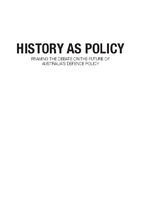History As Policy: Framing the debate on the future of Australia's defence policy
| dc.contributor.author | Huisken, Ron | |
| dc.contributor.author | Thatcher, Meredith | |
| dc.date.accessioned | 2013-11-11 00:00:00 | |
| dc.date.accessioned | 2020-04-01T14:54:54Z | |
| dc.date.available | 2020-04-01T14:54:54Z | |
| dc.date.issued | 2007 | |
| dc.identifier | 459265 | |
| dc.identifier | OCN: 975224620 | en_US |
| dc.identifier.uri | http://library.oapen.org/handle/20.500.12657/33733 | |
| dc.description.abstract | The fortieth anniversary of the Strategic and Defence Studies Centre’s founding provided the opportunity to assemble many of Australia’s leading analysts and commentators to review some of the more significant issues that should define Australian defence policy. In the first 20 years after its establishment, SDSC scholars played a prominent role in shaping the ideas and aspirations that eventually found official expression in the 1987 Defence of Australia White Paper. This policy sustained a coherent balance between strategy, force structure and budgets for well over a decade. In recent years, however, the cumulative effects of the end of the Cold War and watershed events like the East Timor experience; the attacks on New York and Washington, D.C., in September 2001; the Bali bombings in October 2002; and the invasion of Iraq in March 2003 have fractured the former consensus on defence policy. These developments have eroded acceptance of the core judgements underpinning defence policy. This has led to a more tenuous connection between some recent major equipment acquisitions and declared policy. The unravelling of the consensus on the ‘defence of Australia’ policy means that we must again undertake a balanced, long-term assessment of the nature of Australia’s strategic interests. Only by doing so can we determine the kinds of armed forces that would contribute most effectively to protecting those interests. The papers collected in this volume are not informed by a common view of where Australia should focus its defence policy, but all address themes that should figure prominently in this difficult but essential task. | |
| dc.language | English | |
| dc.relation.ispartofseries | Canberra Papers on Strategy and Defence | |
| dc.subject.classification | thema EDItEUR::N History and Archaeology::NH History::NHW Military history | en_US |
| dc.subject.other | defence | |
| dc.subject.other | australia | |
| dc.subject.other | history | |
| dc.subject.other | national security | |
| dc.subject.other | military policy | |
| dc.subject.other | China | |
| dc.subject.other | United States | |
| dc.title | History As Policy: Framing the debate on the future of Australia's defence policy | |
| dc.type | book | |
| oapen.identifier.doi | 10.26530/OAPEN_459265 | |
| oapen.relation.isPublishedBy | ddc8cc3f-dd57-40ef-b8d5-06f839686b71 | |
| oapen.series.number | 167 | |
| oapen.pages | 201 | |
| oapen.place.publication | Canberra | |
| oapen.remark.public | Relevant Wikipedia pages: Australia - https://en.wikipedia.org/wiki/Australia; China - https://en.wikipedia.org/wiki/China; Military history of Australia during World War II - https://en.wikipedia.org/wiki/Military_history_of_Australia_during_World_War_II; United States - https://en.wikipedia.org/wiki/United_States | |
| oapen.identifier.ocn | 975224620 |

